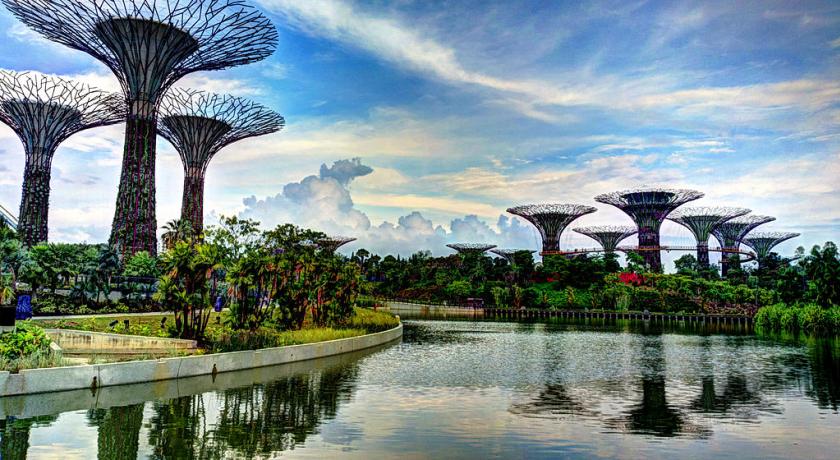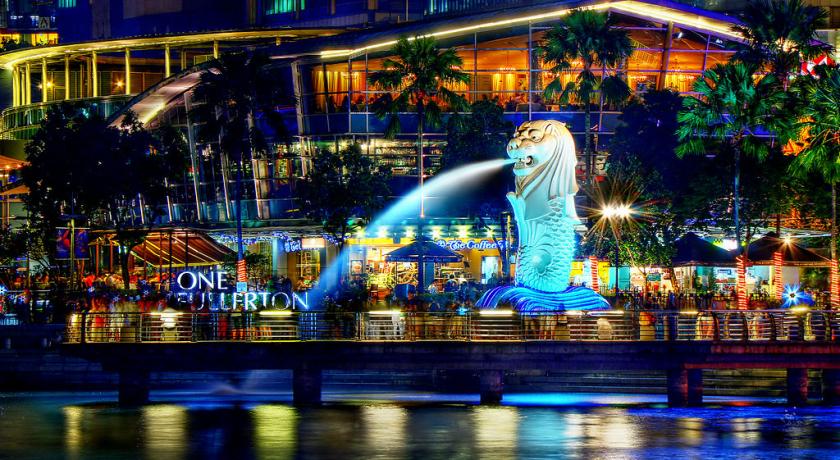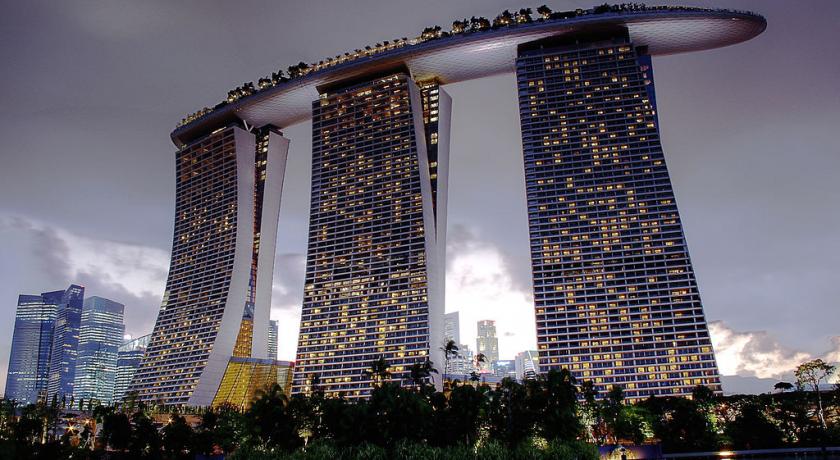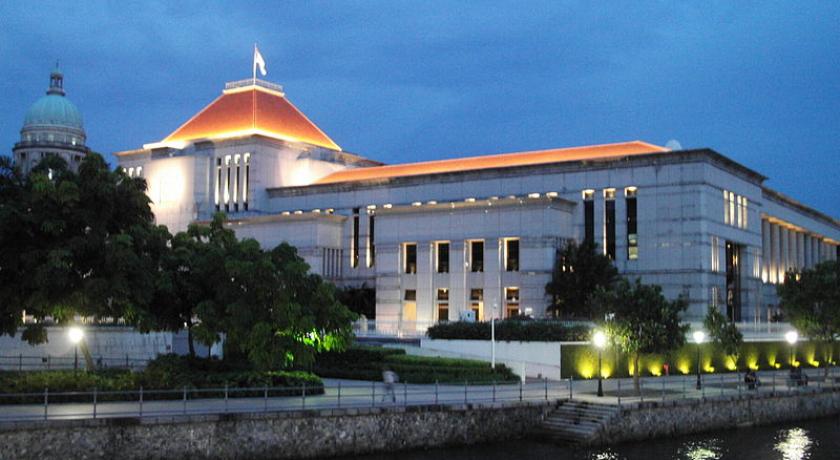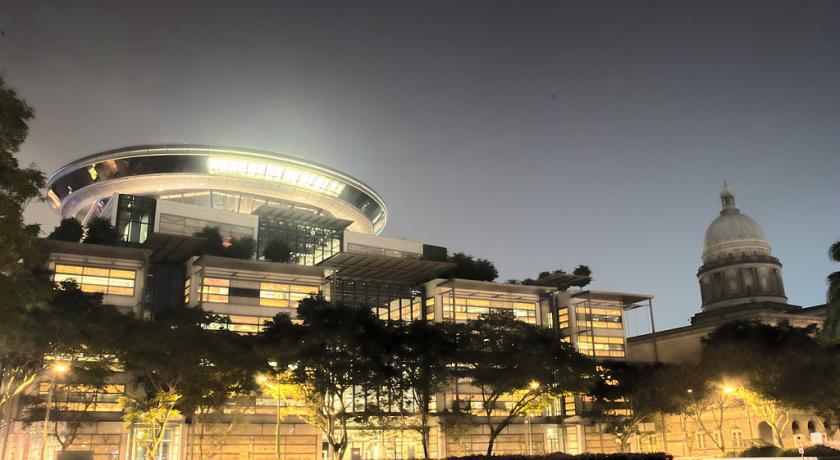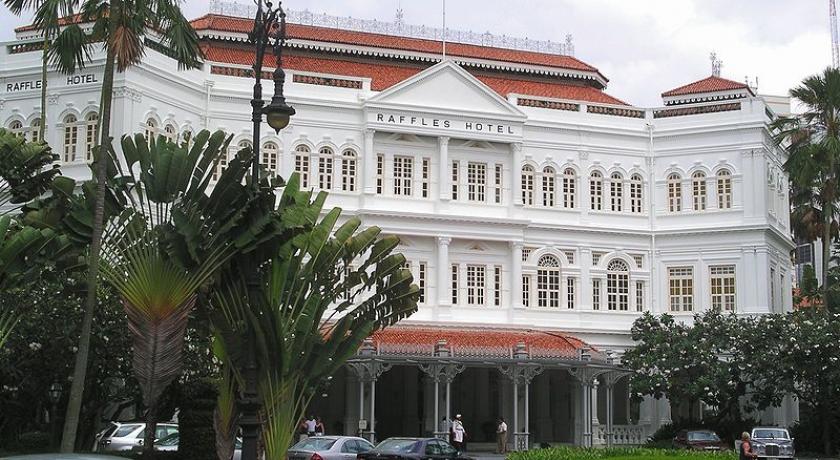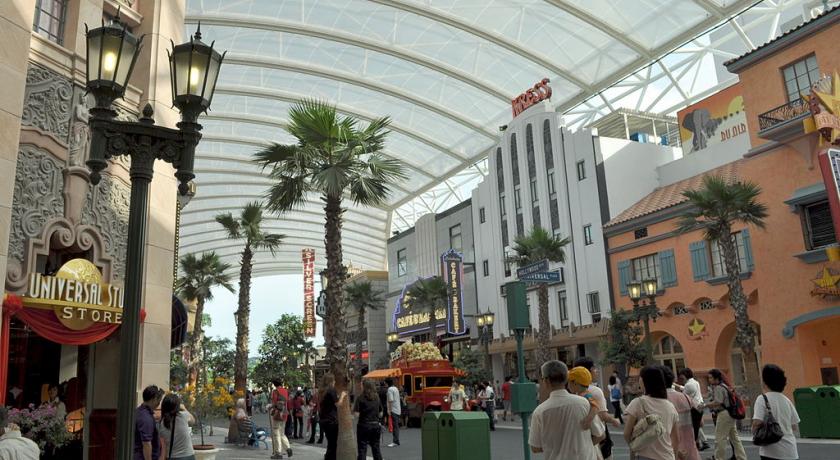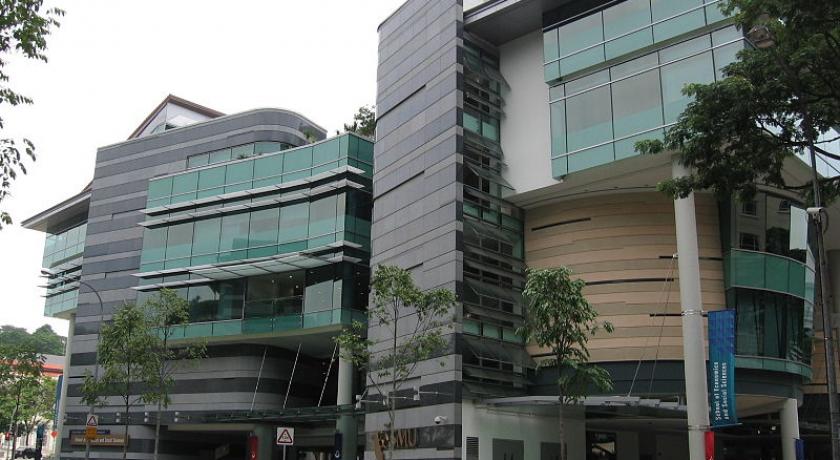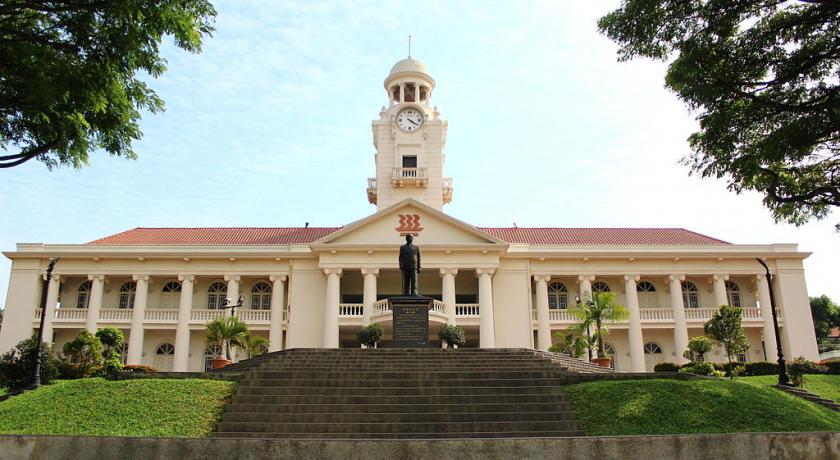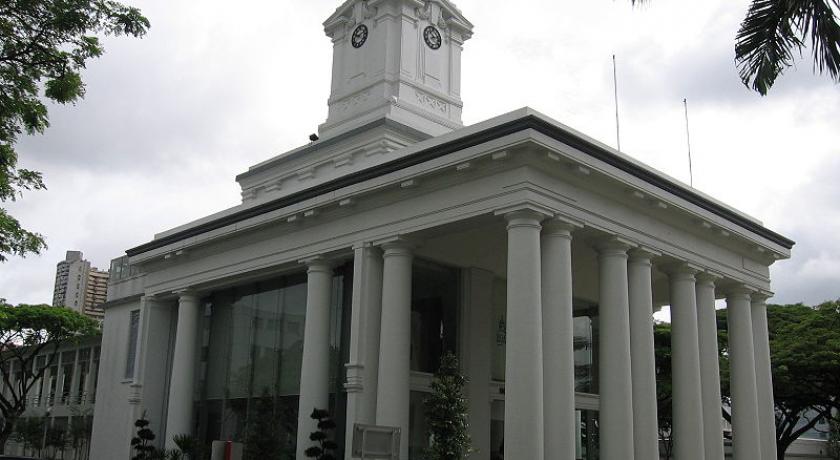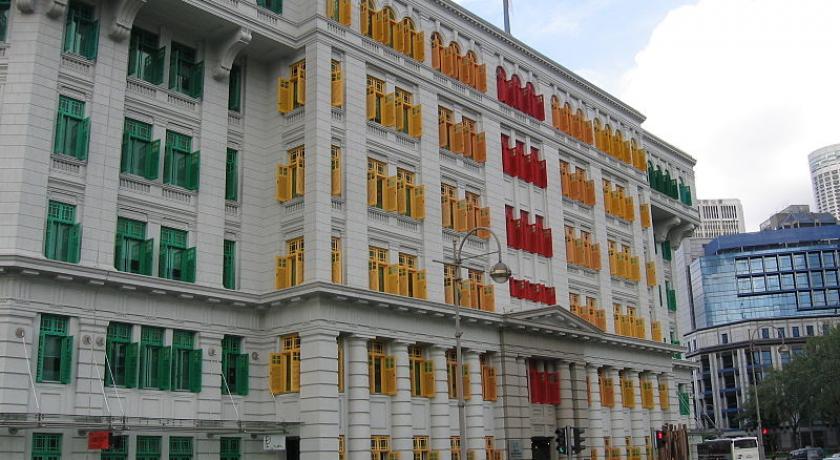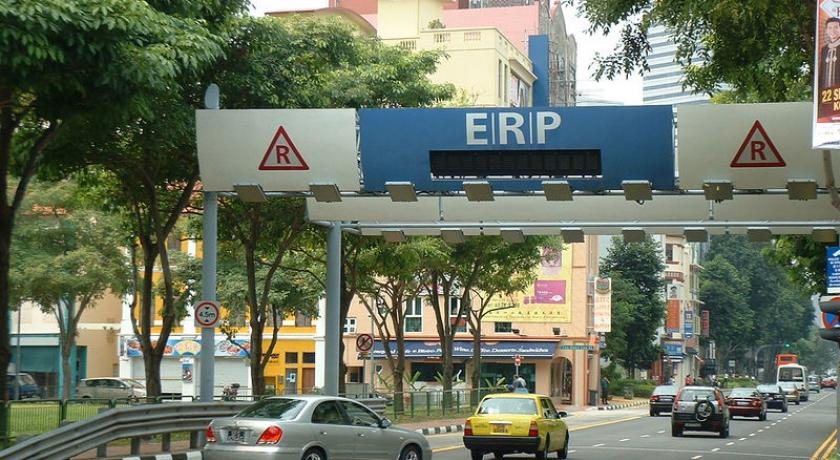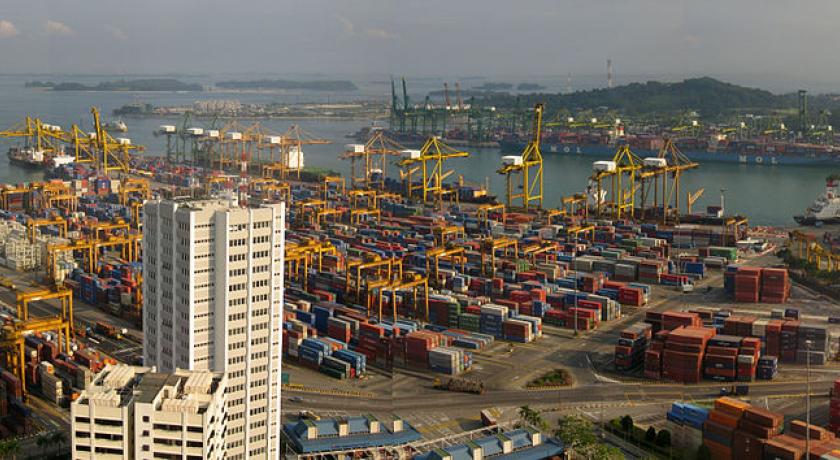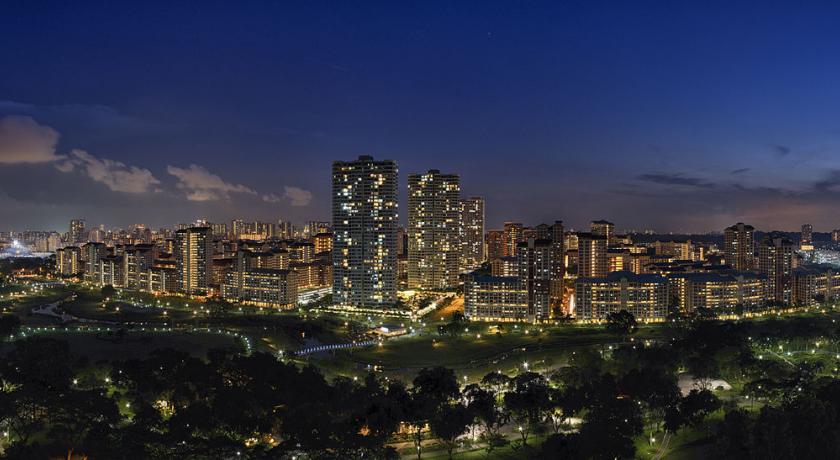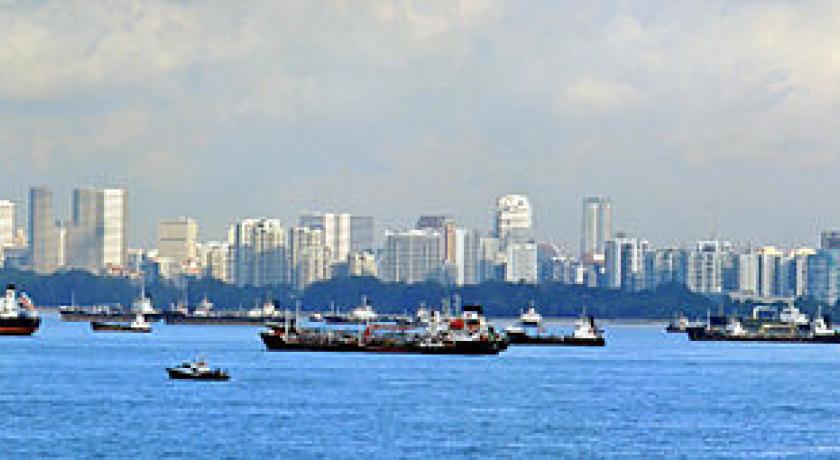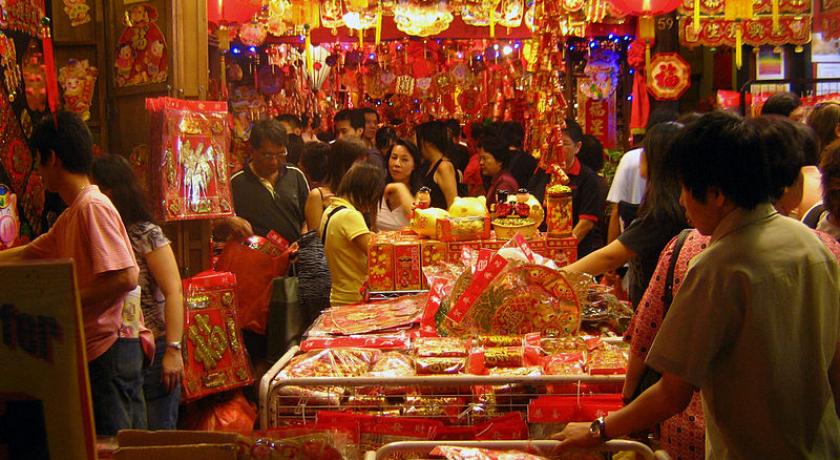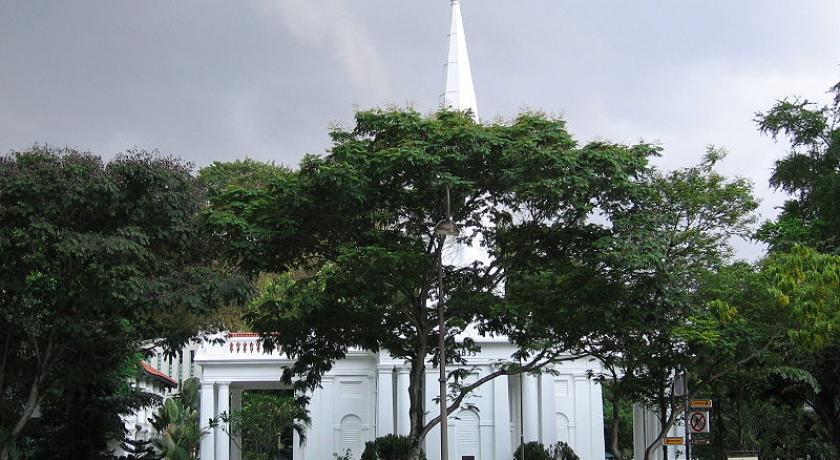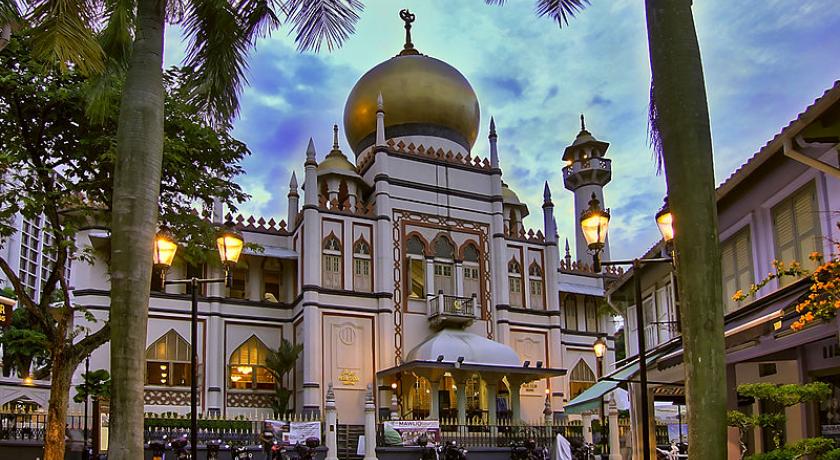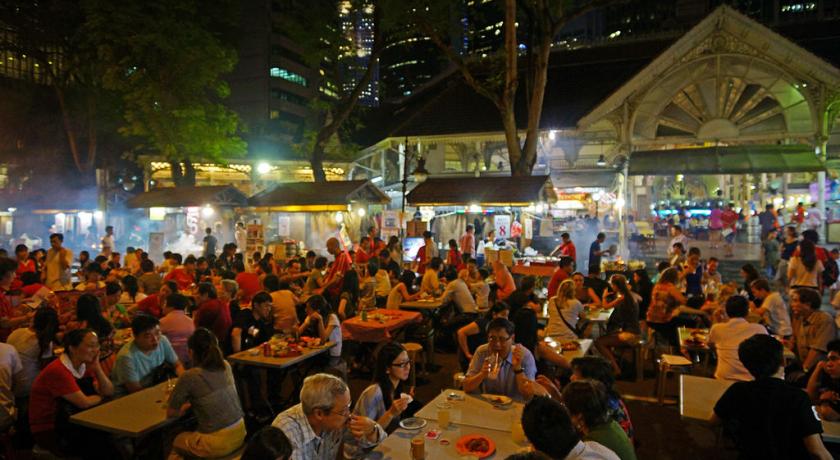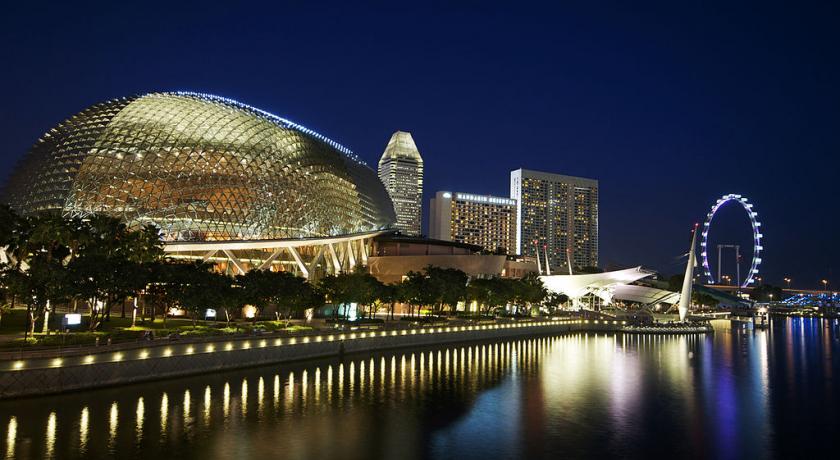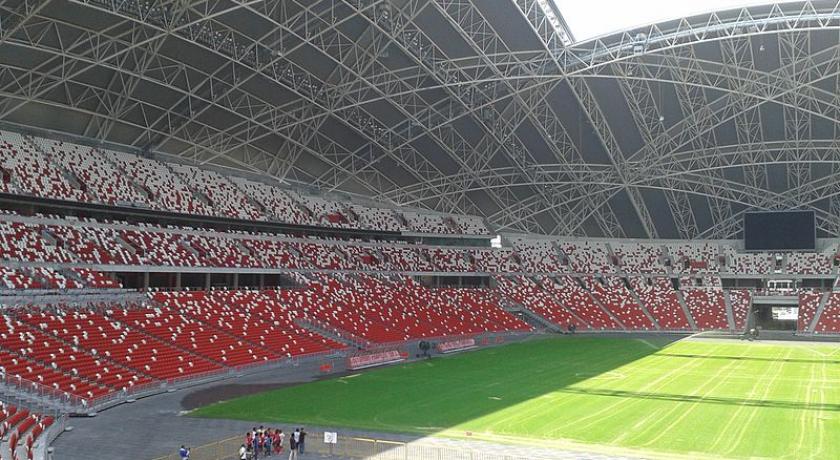Guide description
Singapore, officially the Republic of Singapore, and often referred to as the Lion City, the Garden City, and the Red Dot, is a global city and sovereign state in Southeast Asia and the world's only island city-state. It lies one degree (137 km) north of the equator, at the southernmost tip of continental Asia and peninsular Malaysia, with Indonesia's Riau Islands to the south. Singapore's territory consists of the diamond-shaped main island and 62 islets. Since independence, extensive land reclamation has increased its total size by 23% (130 km2), and its greening policy has covered the densely populated island with tropical flora, parks and gardens.
The islands were settled from the second century AD by a series of local empires. In 1819, Sir Stamford Raffles founded modern Singapore as a trading post of the East India Company; after the company collapsed, the islands were ceded to Britain and became part of its Straits Settlements in 1826. During World War II, Singapore was occupied by Japan. It gained independence from Britain in 1963, by uniting with other former British territories to form Malaysia, but was expelled two years later over ideological differences. After early years of turbulence, and despite lacking natural resources and a hinterland, the nation developed rapidly as an Asian Tiger economy, based on external trade and its human capital.
Singapore is a global commerce, finance and transport hub. Its standings include: "easiest place to do business" (World Bank) for ten consecutive years, most "technology-ready" nation (WEF), top International-meetings city (UIA), city with "best investment potential" (BERI), 2nd-most competitive country (WEF), 3rd-largest foreign exchange centre, 3rd-largest financial centre, 3rd-largest oil refining and trading centre and one of the top two busiest container ports since the 1990s. Singapore's best known global brands include Singapore Airlines and Changi Airport, both amongst the most-awarded in their industry; SIA is also rated by Fortune surveys as Asia's "most admired company". For the past decade, it has been the only Asian country with the top AAA sovereign rating from all major credit rating agencies, including S&P, Moody's and Fitch.
Singapore ranks high on its national social policies, leading Asia and 11th globally, on the Human Development Index (UN), notably on key measures of education, healthcare, life expectancy, quality of life, personal safety, and housing. Although income inequality is high, 90% of citizens own their homes, and the country has one of the highest per capita incomes, with low taxes. The cosmopolitan nation is home to 5.5 million residents, 38% of whom are permanent residents and other foreign nationals. Singaporeans are mostly bilingual in a mother-tongue language and English as their common language. Its cultural diversity is reflected in its extensive ethnic "hawker" cuisine and major festivals—Chinese, Malay, Indian, Western—which are all national holidays. In 2015, Lonely Planet and The New York Times listed Singapore as their top and 6th best world destination to visit respectively.
The nation's core principles are meritocracy, multiculturalism and secularism. It is noted for its effective, pragmatic and incorrupt governance and civil service, which together with its rapid development policies, is widely cited as the "Singapore model". Gallup polls shows 84% of its residents expressed confidence in the national government, and 85% in its judicial systems—one of the highest ratings recorded. Singapore has significant influence on global affairs relative to its size, leading some analysts to classify it as a middle power. It is ranked as Asia's most influential city and 4th in the world by Forbes.
Singapore is a unitary, multiparty, parliamentary republic, with a Westminster system of unicameral parliamentary government. The People's Action Party has won every election since self-government in 1959.
One of the five founding members of the ASEAN, Singapore is also the host of the Asia-Pacific Economic Cooperation (APEC) Secretariat, and a member of the East Asia Summit, Non-Aligned Movement, and the Commonwealth of Nations.
Etymology
The English name of Singapore is derived from the Malay word, Singapura, which was in turn derived from Sanskrit, hence the customary reference to the nation as the Lion City, and its inclusion in many of the nation's symbols (e.g., its coat of arms, Merlion emblem). However, it is unlikely that lions ever lived on the island; Sang Nila Utama, who founded and named the island Singapura, most likely saw a Malayan tiger. It is also known as Pulau Ujong, as far back as the 3rd century, literally 'island at the end' (of the Malay Peninsula) in Malay.
Since the 1970s, Singapore has also been widely known as the Garden City, owing to its extensive greening policy covering the whole island, a priority of its first Prime Minister Lee Kuan Yew, dubbed the nation's "Chief Gardener". The nation's conservation and greening efforts contributed to Singapore Botanic Gardens being the only tropical garden to be inscribed by UNESCO as a World Heritage Site. The nickname, Red Dot, is a reference to its size on the map, contrasting with its achievements. In 2015, Singapore's Golden Jubilee year, the celebratory "SG50" branding is depicted inside a red dot.
History
Temasek ('Sea Town' in the Malay language), an outpost of the Sumatran Srivijaya empire, is the earliest written record relating to the area now called Singapore. In the 13th century, the Kingdom of Singapura was established on the island and it became a trading port city. However, there were two major foreign invasions before it was destroyed by the Majapahit in 1398. In 1613, Portuguese raiders burned down the settlement, which by then was nominally part of the Johor Sultanate and the island sank into obscurity for the next two centuries, while the wider maritime region and much trade was under Dutch control.
British colonisation 1819–1942
In 1819, Thomas Stamford Raffles arrived and signed a treaty with Sultan Hussein Shah of Johor, on behalf of the British East India Company, to develop the southern part of Singapore as a British trading post. In 1824, the entire island, as well as the Temenggong, became a British possession after a further treaty with the Sultan. In 1826, Singapore became part of the Straits Settlements, under the jurisdiction of British India, becoming the regional capital in 1836.
Prior to Raffles' arrival, there were only about a thousand people living on the island, mostly indigenous Malays along with a handful of Chinese. By 1860, the population had swelled to more than 80,000 and more than half were Chinese. Many immigrants came to work at rubber plantations and, after the 1870s; the island became a global centre for rubber exports.
After the First World War, the British built the large Singapore Naval Base. Lieutenant General Sir William George Shedden Dobbie was appointed General Officer Commanding of the Malaya Command on 8 November 1935, holding the post until 1939;
World War II and Japanese occupation 1942–45
In May 1938, the General Officer Commanding of the Malaya Command warned how Singapore could be conquered by the Japanese via an attack from northern Malaya, but his warnings went unheeded. The Imperial Japanese Army invaded British Malaya, culminating in the Battle of Singapore. When the British surrendered on 15 February 1942, British Prime Minister Winston Churchill called the defeat "the worst disaster and largest capitulation in British history". Between 5,000 and 25,000 ethnic Chinese people were killed in the subsequent Sook Ching massacre.
From November 1944 to May 1945, the Allies conducted an intensive bombing of Singapore.
Return of the British 1945–59
After the surrender of Japan was announced in the Jewel Voice Broadcast by the Japanese Emperor on 15 August 1945 there was a breakdown of order and looting and revenge-killing were widespread. The formal Japanese Occupation of Singapore was only ended by Operation Tiderace and the formal surrender on 12 September 1945 at Singapore City Hall when Lord Louis Mountbatten, Supreme Allied Commander of Southeast Asia Command, accepted the capitulation of Japanese forces in Southeast Asia from General Itagaki Seishiro.
A British Military Administration was then formed to govern the island. On 1 April 1946, the Straits Settlements were dissolved and Singapore became a separate Crown Colony with a civil administration headed by a Governor. Much of the infrastructure had been destroyed during the war, including the harbour, electricity, telephone and water supply systems. There was also a shortage of food leading to malnutrition, disease, and rampant crime and violence. High food prices, unemployment, and workers' discontent culminated into a series of strikes in 1947 causing massive stoppages in public transport and other services. In July 1947, separate Executive and Legislative Councils were established and the election of six members of the Legislative Council was scheduled for the following year. By late 1947, the economy began to recover, facilitated by a growing demand for tin and rubber around the world, but it would take several more years before the economy returned to pre-war levels.
The failure of Britain to defend Singapore had destroyed its credibility as an infallible ruler in the eyes of Singaporeans. The decades after the war saw a political awakening amongst the local populace and the rise of anti-colonial and nationalist sentiments, epitomized by the slogan Merdeka, or "independence" in the Malay language.
During the 1950s, Chinese Communists with strong ties to the trade unions and Chinese schools carried out armed uprising against the government, leading to the Malayan Emergency and later, the Communist Insurgency War. The 1954 National Service Riots, Chinese middle schools riots, and Hock Lee bus riots in Singapore were all linked to these events.
David Marshall, pro-independence leader of the Labour Front, won Singapore's first general election in 1955. He led a delegation to London, but Britain rejected his demand for complete self-rule. He resigned and was replaced by Lim Yew Hock, whose policies convinced Britain to grant Singapore full internal self-government for all matters except defense and foreign affairs.
Self-government 1959–63
During the May 1959 elections, the People's Action Party won a landslide victory. Singapore became an internally self-governing state within the Commonwealth, with Lee Kuan Yew as its first Prime Minister. Governor Sir William Allmond Codrington Goode served as the first Yang di-Pertuan Negara (Head of State), and was succeeded by Yusof bin Ishak, who became the first President of Singapore in 1965.
Merger with Malaysia 1963–65
As a result of the 1962 Merger Referendum, on 31 August 1963 Singapore joined with the Federation of Malaya, the Crown Colony of Sarawak and the Crown Colony of North Borneo to form the new federation of Malaysia under the terms of the Malaysia Agreement. Singaporean leaders chose to join Malaysia primarily due to concerns over its limited land size, scarcity of water, markets and natural resources. Some Singaporean and Malaysian politicians were also concerned that the communists might form the government on the island, a possibility perceived as an external threat to the Federation of Malaya.
However, shortly after the merger, the Singapore state government and the Malaysian central government disagreed on many political and economic issues, and communal strife culminated in the 1964 race riots in Singapore. After many heated ideological conflicts between the two governments, on 9 August 1965, the Malaysian Parliament voted 126 to 0 to expel Singapore from Malaysia with Singaporean delegates not present.
Independence 1965–present
Singapore gained independence as the Republic of Singapore (remaining within the Commonwealth of Nations) on 9 August 1965. Race riots broke out once more in 1969. In 1967, the country co-founded ASEAN, the Association of Southeast Asian Nations, and in 1970 it joined the Non-Aligned Movement. Lee Kuan Yew became Prime Minister, leading its Third World economy to First World affluence in a single generation. His emphasis on rapid economic growth, support for business entrepreneurship, limitations on internal democracy, and close relationships with China set the new nation's policies for the next half-century.
In 1990, Goh Chok Tong succeeded Lee as Prime Minister, while the latter continued serving in the Cabinet as Senior Minister until 2004, and then Minister Mentor until May 2011. During Goh's tenure, the country faced the 1997 Asian financial crisis, the 2003 SARS outbreak and terrorist threats posed by Jemaah Islamiyah.
In 2004, Lee Hsien Loong, the eldest son of Lee Kuan Yew, became the country's third Prime Minister. Goh Chok Tong remained in Cabinet as the Senior Minister until May 2011, when he was named Emeritus Senior Minister despite his retirement. He steered the nation through the 2008 global financial crisis, resolved the disputed 79-year old Malayan railways land, and introduced integrated resorts. Despite the economy's exceptional growth, PAP suffered its worst election results in 2011, winning 60% of votes, amidst hot-button issues of high influx of foreign workers and cost of living. Lee initiated a major re-structuring of the economy to raise productivity, improved universal healthcare and grants, especially for the pioneer generation of citizens, amongst many new inclusive measures.
On 23 March 2015, it’s founding prime minister, Lee Kuan Yew, who had 'personified Singapore to the world' for nearly half a century died. In a week of national mourning, 1.7 million residents and guests paid tribute to him at his lying-in-state at Parliament House and at community sites around the island.
Singapore celebrated its Golden jubilee in 2015 – its 50th year of independence, with a year-long series of events branded SG50. The PAP maintained its dominance in Parliament at the September general elections, receiving 69.9% of the popular vote, its second-highest polling result behind the 2001 tally of 75.3%.
Geography
Singapore consists of 63 islands, including the main island, Pulau Ujong. There are two man-made connections to Johor, Malaysia: the Johor–Singapore Causeway in the north and the Tuas Second Link in the west. Jurong Island, Pulau Tekong, Pulau Ubin and Sentosa are the largest of Singapore's smaller islands. The highest natural point is Bukit Timah Hill at 163.63 m (537 ft).
Ongoing land reclamation projects have increased Singapore's land area from 581.5 km2 (224.5 sq mi) in the 1960s to 719.1 km2 (277.6 sq mi) in 2015, an increase of some 23% (130 km2). The country is projected to grow by another 100 km2 (40 sq mi) by 2030. Some projects involve merging smaller islands through land reclamation to form larger, more functional islands, as has been done with Jurong Island.
Nearly 10% of Singapore's land has been set aside for parks and nature reserves. The network of nature reserves, parks, park connectors, nature ways, tree-lined roads and other natural areas have enhanced the sense of green space in the city. This is a result of five decades of greening efforts, which began in 1963, when Prime Minister Lee Kuan Yew launched Singapore's first tree-planting campaign by planting a mempat tree (Cratoxylum formosum). The aim was to soften the harshness of urbanisation and improve the quality of life. This initiative continued into the 1970s and 1980s under the Parks and Recreation Department (PRD), renamed the National Parks Board (abbreviation: NParks) in July 1996.
Due to these efforts, Singapore was ranked fourth in the 2014 Environmental Performance Index, which measures the effectiveness of state policies for environmental sustainability.
Biodiversity
Singapore's environment has changed drastically due to rapid urbanization and immense population density. In 1819, when a British trading post was first established on the island, Singapore was still nearly entirely covered in rainforests. During that time it still contained flora shared with the Malay Peninsula, but the biodiversity of the fauna was even then relatively low. Following the establishment of the trading post, rapid deforestation began due to crop cultivation. Deforestation of Singapore was largely completed by the 20th century. By some estimates, there has been a loss of 95% of the natural habitats of Singapore over the course of the past 183 years.
In modern times, over half of the naturally occurring fauna and flora in Singapore is present only in nature reserves, such as the Bukit Timah Nature Reserve and the Sungei Buloh Wetland Reserve, which comprise only 0.25% of Singapore's land area.
To combat these problems, the Singaporean government has made the Singapore Green Plan in 1992 and the new Singapore Green Plan in 2012 to continue it. The plan aims to keep tabs on the unstable populations of fauna and flora, to place new nature parks, and to connect existing parks. In addition, there are plans to set up a "National Biodiversity Reference Centre" (now known as the National Biodiversity Centre).
Government and politics
Singapore is a parliamentary republic with a Westminster system of unicameral parliamentary government representing constituencies. The country's constitution establishes a representative democracy as the political system. Executive power rests with the Cabinet of Singapore, led by the Prime Minister and, to a much lesser extent, the President. The President is elected through a popular vote, and has veto powers over a specific set of executive decisions, such as the use of the national reserves and the appointment of judges, but otherwise occupies a largely ceremonial post.
The Parliament serves as the legislative branch of the government. Members of Parliament (MPs) consist of elected, non-constituency and nominated members. Elected MPs are voted into the Parliament on a "first-past-the-post" (plurality) basis and represent either single-member or group representation constituencies. The People's Action Party has won control of Parliament with large majorities in every election since self-governance was secured in 1959.
Although the elections are clean, there is no independent electoral authority and the government has strong influence on the media. Freedom House ranks Singapore as "partly free" in its Freedom in the World report, and The Economist ranks Singapore as a "flawed democracy", the second best rank of four, in its "Democracy Index". Despite this, in the 2011 Parliamentary elections, the opposition, led by the Workers' Party, increased its representation to seven elected MPs. In the 2015 elections, PAP scored a landslide victory, winning 83 of 89 seats contested, with 70% of popular votes. Gallup polls reported 84% of residents in Singapore expressed confidence in the government and 85% in its judicial systems and courts – one of the highest ratings in the world.
Singapore's governance model eschews populist politics, focusing on the nation's long-term interest, and is known to be clean, effective and pragmatic. As a small nation highly dependent on external trade, it is vulnerable to geo-politics and global economics. It places great emphasis on security and stability of the region in its foreign policies, and applies global best practices to ensure the nation's attractiveness as an investment destination and business hub.
The legal system of Singapore is based on English common law, but with substantial local differences. Trial by jury was abolished in 1970 so that judicial decisions would rest entirely in the hands of appointed judges. Singapore has penalties that include judicial corporal punishment in the form of caning, which may be imposed for such offences as rape, rioting, vandalism, and certain immigration offences. There is a mandatory death penalty for murder, as well as for certain aggravated drug-trafficking and firearms offences.
Amnesty International has said that some legal provisions of the Singapore system conflict with the right to be presumed innocent until proven guilty, and that Singapore has "... possibly the highest execution rate in the world relative to its population". The government has disputed Amnesty's claims. In a 2008 survey of international business executives, Singapore received the top ranking with regard to judicial system quality in Asia. Singapore has been consistently rated among the least corrupt countries in the world by Transparency International.
In 2011, the World Justice Project's Rule of Law Index ranked Singapore among the top countries surveyed with regard to "order and security", "absence of corruption", and "effective criminal justice". However, the country received a much lower ranking for "freedom of speech" and "freedom of assembly". All public gatherings of five or more people require police permits, and protests may legally be held only at the Speakers' Corner.
Foreign relations
Singapore's foreign policy is aimed at maintaining security in Southeast Asia and surrounding territories. An underlying principle is political and economic stability in the region. It has diplomatic relations with more than 180 sovereign states. Since 2002, it has hosted the annual inter-government security forum Shangri-La Dialogue, by the International Institute for Strategic Studies, attended by ministers and defense officials from the Asia-Pacific and Europe. The high-level dialogue has had influence on confrontational issues, such as territorial disputes in the East and South China seas, together with discussions about global security and terrorism.
As one of the five founding members of ASEAN, it is a strong supporter of the ASEAN Free Trade Area (AFTA) and the ASEAN Investment Area, because Singapore's economy is closely linked to that of the region as a whole. Former Prime Minister Goh Chok Tong proposed the formation of an ASEAN Economic Community, a step beyond the current AFTA, bringing it closer to a common market. This was agreed to in 2007 for implementation by 2015. Other regional organisations are important to Singapore, and it is the host of the APEC Secretariat. Singapore maintains membership in other regional organisations, such as Asia–Europe Meeting, the Forum for East Asia-Latin American Cooperation, the Asian Network of Major Cities 21, and the East Asia Summit. It is also a member of the Non-Aligned Movement and the Commonwealth.
In general, bilateral relations with other ASEAN members are strong; however, disagreements have arisen, and relations with neighbouring Malaysia and Indonesia have sometimes been strained. Malaysia and Singapore have clashed over the delivery of fresh water to Singapore, and access by the Singapore Armed Forces to Malaysian airspace. Border issues exist with Malaysia and Indonesia, and both have banned the sale of marine sand to Singapore over disputes about Singapore's land reclamation. Some previous disputes have been resolved by the International Court of Justice. Piracy in the Strait of Malacca has been a cause of concern for all three countries. Close economic ties exist with Brunei and the two shares a pegged currency value.
The first diplomatic contact with China was made in the 1970s, with full diplomatic relations established in the 1990s. Since then the two countries have been major players in strengthening the ASEAN–China relationship. Singapore and the United States share a long-standing close relationship, in particular in defense, the economy, health, and education. The United States was Singapore's third largest trading partner in 2010, behind China (2nd) and Malaysia (1st). The two countries have a free-trade agreement, and Singapore views its relationship with the United States as an important counterbalance to China's influence. A Strategic Framework Agreement between the two, signed in 2005, formalises security and defense co-operation. Singapore has pushed regional counter-terrorism initiatives, with a strong resolve to deal with terrorists inside its borders. To this end it has given support to the US-led coalition to fight terrorism, with bilateral co-operation in counter-terrorism and counter-proliferation initiatives, and joint military exercises.
Military
The Singaporean military is arguably the most technologically advanced in Southeast Asia. It comprises the Singapore Army, Republic of Singapore Navy, and Republic of Singapore Air Force. It is seen as the guarantor of the country's independence. The nation's philosophy of defense is one of diplomacy and deterrence. This principle translates into the culture, involving all citizens in the country's defense. The government spends 4.9% of the country's GDP on the military, and one out of every four dollars of government spending is spent on defense.
After its independence, Singapore had two infantry regiments commanded by British officers. This force was considered too small to provide effective security for the new country, so development of its military forces became a priority. Britain pulled its military out of Singapore in October 1971, leaving behind only a small British, Australian and New Zealand force as a token military presence. The last British soldier left Singapore in March 1976. New Zealand troops were the last to leave, in 1989.
A great deal of initial support came from Israel, a country that is not recognised by the neighbouring Muslim-majority nations of Malaysia, Indonesia, or Brunei. The main fear after independence was an invasion by Malaysia. Israeli Defense Force (IDF) commanders were tasked with creating the Singapore Armed Forces (SAF) from scratch, and Israeli instructors were brought in to train Singaporean soldiers. Military courses were conducted according to the IDF's format, and Singapore adopted a system of conscription and reserve service based on the Israeli model. Singapore still maintains strong security ties with Israel and is one of the biggest buyers of Israeli arms and weapons systems. The MATADOR is one example of recent Singaporean–Israeli collaboration.
The SAF is being developed to respond to a wide range of issues, in both conventional and unconventional warfare. The Defense Science and Technology Agency is responsible for procuring resources for the military. The geographic restrictions of Singapore mean that the SAF must plan to fully repulse an attack, as they cannot fall back and re-group. The small size of the population has also affected the way the SAF has been designed, with a small active force but a large number of reserves.
Singapore has conscription for all able-bodied males at age 18, except those with a criminal record or who can prove that their loss would bring hardship to their families. Males who have yet to complete pre-university education or are awarded the Public Service Commission scholarship can opt to defer their draft. Though not required to perform military service, the number of women in the SAF has been increasing: since 1989 they have been allowed to fill military vocations formerly reserved for men. Before induction into a specific branch of the armed forces, recruits undergo at least 9 weeks of basic military training.
Because of the scarcity of open land on the main island, training involving activities such as live firing and amphibious warfare is often carried out on smaller islands, typically barred to civilian access. This also avoids risk to the main island and the city. However, large-scale drills are considered too dangerous to be performed in the area, and since 1975 have been performed in Taiwan. Training is also held in about a dozen other countries. In general, military exercises are held with foreign forces once or twice per week. In May 2016, Singapore and Australia announced a A$2.25 billion 'comprehensive strategic partnership' over 25 years, to expand its military training bases in Queensland to 10 times the size of Singapore, supporting 14,000 personnel to be trained each year.
Due to airspace and land constraints, the Republic of Singapore Air Force (RSAF) maintains a number of overseas bases in Australia, the United States, and France. The RSAF's 130 Squadron is based in RAAF Base Pearce, Western Australia, and its 126 Squadron is based in the Oakey Army Aviation Centre, Queensland. The RSAF has one squadron—the 150 Squadron—based in Cazaux Air Base in southern France. The RSAF also has a few overseas detachments in the United States, in San Diego, California, Marana, Arizona, Grand Prairie, Texas and Luke Air Force Base, among others.
The SAF has sent forces to assist in operations outside the country, in areas such as Iraq and Afghanistan, in both military and civilian roles. In the region, it has helped stabilise East Timor and has provided aid to Aceh in Indonesia following the 2004 Indian Ocean earthquake and tsunami. In 2014, the RSN deployed two ships, the RSS Resolute and the Tenacious to the Gulf of Aden to aid in counter piracy efforts as part of Task Force 151. The SAF also helped in relief efforts during Hurricane Katrina and Typhoon Haiyan. Singapore is part of the Five Power Defense Arrangements, a military alliance with Australia, Malaysia, New Zealand, and the United Kingdom.
Economy
Pre-independence economy
Before independence in 1965, Singapore was the capital of the British Straits Settlements, a Crown Colony. Because it held the main British naval base in East Asia and the largest dry dock of its time, Singapore was commonly described in the press as the 'Gibraltar of the East'. The opening of the Suez Canal in 1869 led to a major increase in trade between Europe and Asia, helping Singapore become a major world trade centre, and the Port of Singapore became the largest and busiest ports in the world from the 1990s. Prior to 1965, Singapore had a GDP per capita of $511. After independence, the combination of foreign direct investment and a state-led drive for industrialisation, based on plans by Goh Keng Swee and Albert Winsemius, started the expansion of the country's economy.
Modern-day economy
Singapore has a highly developed market economy, based historically on extended entrepôt trade. Along with Hong Kong, South Korea, and Taiwan, Singapore is one of the original Four Asian Tigers, but has surpassed its peers in terms of GDP per capita. The Singaporean economy is known as one of the freest, most innovative, most competitive, most dynamic and most business-friendly. The 2015 Index of Economic Freedom ranks Singapore as the second freest economy in the world. According to the Corruption Perceptions Index, Singapore is consistently ranked as one of the least corrupt countries in the world, along with New Zealand and the Scandinavian countries.
For the past decade, Singapore has been the only Asian country to receive top-tier AAA sovereign ratings from all major credit rating agencies, including Standard & Poor's, Moody's, Fitch. Globally, it is one of only nine countries with an AAA rating from the Big Three (credit rating agencies). Singapore attracts a large amount of foreign investment as a result of its location, skilled workforce, low tax rates, advanced infrastructure and zero-tolerance against corruption. There are more than 7,000 multinational corporations from the United States, Japan, and Europe in Singapore. There are also approximately 1,500 companies from China and a similar number from India. Foreign firms are found in almost all sectors of the country's economy. Singapore is also the second-largest foreign investor in India. Roughly 44 percent of the Singaporean workforce is made up of non-Singaporeans. Over ten free-trade agreements have been signed with other countries and regions. Despite market freedom, Singapore's government operations have a significant stake in the economy, contributing 22% of the GDP.
Singapore is considered a barometer of global economic health, especially within Asia, owing to its high dependence on external trade. Its foreign trade and capital flows are 407.9% of its GDP, making it the most trade dependent country in the world. It is the 14th largest exporter and the 15th largest importer in the world.
Singapore has the world's eleventh largest foreign reserves and one of the highest net international investment positions per capita.
The currency of Singapore is the Singapore dollar (SGD or S$), issued by the Monetary Authority of Singapore (MAS). It is interchangeable with the Brunei dollar at par value since 1967, owing to their historically close relations. MAS manage its monetary policy by allowing the Singapore dollar exchange rate to rise or fall within an undisclosed trading band. This is different from most central banks, which use interest rates to manage policy. In recent years, the country has been identified as an increasingly popular tax haven for the wealthy due to the low tax rate on personal income and tax exemptions on foreign-based income and capital gains. Australian millionaire retailer Brett Blundy and multi-billionaire Facebook co-founder Eduardo Saverin are two examples of wealthy individuals who have settled in Singapore (Blundy in 2013 and Saverin in 2012). Singapore ranked fifth on the Tax Justice Network's 2013 Financial Secrecy Index of the world's top tax havens, scoring narrowly ahead of the United States.
Singapore has the world's highest percentage of millionaires, with one out of every six households having at least one million US dollars in disposable wealth. This excludes property, businesses, and luxury goods, which if included would increase the number of millionaires, especially as property in Singapore is among the worlds most expensive. Singapore does not have a minimum wage, believing that it would lower its competitiveness. It also has one of the highest income inequalities among developed countries.
Industry sectors
Globally, Singapore is a leader in several economic sectors, including being 3rd-largest foreign exchange centre, 3rd-leading financial centre, and 2nd-largest casino gambling market, 3rd-largest oil-refining and trading centre, world's largest oil-rig producer and major hub for ship repair services, world's top logistics hub.
The economy is diversified, with its top contributors – financial services, manufacturing, and oil-refining. Its main exports are refined petroleum, integrated circuits and computers which constituted 27% of the country's GDP in 2010, and include significant electronics, petroleum refining, chemicals, mechanical engineering and biomedical sciences sectors. In 2006, Singapore produced about 10% of the world's foundry wafer output.
Singapore's largest companies are in the telecoms, banking, transportation and manufacturing sectors, many of which started as state-run enterprises, and have since been listed on the Singapore Exchange, including Singapore Telecommunications (Singtel), Singapore Technologies Engineering, Keppel Corporation, Oversea-Chinese Banking Corporation (OCBC), Development Bank of Singapore (DBS), United Overseas Bank (UOB). In 2011, amidst the global financial crisis, OCBC, DBS and UOB were ranked as the world's 1st, 5th, 6th "strongest banks in the world" respectively by Bloomberg surveys.
The nation's best known global brands include Singapore Airlines, Changi Airport and Port of Singapore; all three are amongst the most-awarded in their respective industry sectors. Singapore Airlines is ranked as Asia's most-admired company, and world's 19th most-admired in 2015, by Fortune's annual "50 most admired companies in the world" industry surveys. It is also the world's most-awarded airline, including "Best international airline", by US-based Travel + Leisure reader surveys, for 20 consecutive years. Changi Airport connects over 100 airlines to more than 300 cities. The strategic international air hub has more than 480 "World's Best Airport" awards as of 2015, and is known as the most-awarded airport in the world.
Tourism forms a large part of the economy, with over 15 million tourists visiting the city-state in 2014. To expand the sector, casinos were legalised in 2005, but only two licenses for "Integrated Resorts" were issued, to control money laundering and addiction. Singapore also promotes itself as a medical tourism hub: about 200,000 foreigners seek medical care there each year. Singapore medical services aim to serve at least one million foreign patients annually and generate USD 3 billion in revenue. In 2015, Lonely Planet and The New York Times listed Singapore as their top and 6th best world destination to visit respectively.
Singapore is an education hub, with more than 80,000 international students in 2006. 5,000 Malaysian students cross the Johor–Singapore Causeway daily to attend schools in Singapore. In 2009, 20% of all students in Singaporean universities were international students, a majority from ASEAN, China and India.
Infrastructure
Information and communications
Information and communications technologies (ICT) are one of the pillars of Singapore's economic success. The World Economic Forum's 2015 Global Technology Report placed Singapore as the most "Tech-Ready Nation". It’s the most comprehensive survey of the pervasiveness and network-readiness of a country, in terms of market, political and regulatory infrastructure for connectivity. Singapore has also topped Waseda University's International e-Government rankings from 2009 to 2013, and 2015.
Singapore has the world's highest smart phone penetration rates, in surveys by Deloitte and Google Consumer Barometer – at 89% and 85% of the population respectively in 2014. Overall mobile phone penetration rate is at 148 mobile phone subscribers per 100 people.
Internet in Singapore is provided by state owned Singtel and partially state owned Starhub and M1 Limited plus some other business internet service providers (ISPs) that offer residential service plans of speeds up to 2 Gbit/s as of Spring 2015.
Equinix (332 participants) and also its smaller brother Singapore Internet Exchange (70 participants) are Internet exchange points where Internet service providers and Content delivery networks exchange Internet traffic between their networks (autonomous systems) in various locations in Singapore.
Transport
As Singapore is a small island with a high population density, the number of private cars on the road is restricted so as to curb pollution and congestion. Car buyers must pay for duties one-and-a-half times the vehicle's market value, and bid for a Singaporean Certificate of Entitlement (COE), which allows the car to run on the road for a decade. The cost of the Singaporean certificate of entitlement alone would buy a Porsche Boxster in the United States. Car prices are generally significantly higher in Singapore than in other English-speaking countries. As with most Commonwealth countries, vehicles on the road and people walking on the streets keep to the left.
Singaporean residents also travel by foot, bicycles, bus, taxis and train (MRT or LRT). Two companies run the public bus and train transport system—SBS Transit and SMRT Corporation. There are six taxi companies, who together put out over 28,000 taxis on the road. Taxis are a popular form of public transport as the fares are relatively cheap compared to many other developed countries.
Singapore has a road system covering 3,356 kilometers (2,085 mi), which includes 161 kilometers (100 mi) of expressways. The Singapore Area Licensing Scheme, implemented in 1975, became the world's first congestion pricing scheme, and included other complementary measures such as stringent car ownership quotas and improvements in mass transit. Upgraded in 1998 and renamed Electronic Road Pricing, the system introduced electronic toll collection, electronic detection, and video surveillance technology.
Singapore is a major international transport hub in Asia, serving some of the busiest sea and air trade routes. Changi Airport is an aviation centre for Southeast Asia and a stopover on the Kangaroo Route between Sydney and London. There are eight airports in the country, and Singapore Changi Airport hosts a network of over 100 airlines connecting Singapore to some 300 cities in about 70 countries and territories worldwide. It has been rated one of the best international airports by international travel magazines, including being rated as the world's best airport for the first time in 2006 by Skytrax. The national airline is Singapore Airlines.
The Port of Singapore, managed by port operators PSA International and Jurong Port, was the world's second-busiest port in 2005 in terms of shipping tonnage handled, at 1.15 billion gross tons, and in terms of containerised traffic, at 23.2 million twenty-foot equivalent units (TEUs). It is also the world's second-busiest, behind Shanghai, in terms of cargo tonnage with 423 million tons handled. In addition, the port is the worlds busiest for transshipment traffic and the world's biggest ship refueling centre.
Water supply and sanitation
Access to water is universal, affordable, efficient and of high quality. Innovative integrated water management approaches such as the reuse of reclaimed water, the establishment of protected areas in urban rainwater catchments and the use of estuaries as freshwater reservoirs have been introduced along with seawater desalination to reduce the country's dependence on water imported from neighbouring Malaysia.
Singapore's approach does not rely only on physical infrastructure, but it also emphasises proper legislation and enforcement, water pricing, public education as well as research and development. In 2007 Singapore's water and sanitation utility, the Public Utilities Board, received the Stockholm Industry Water Award for its holistic approach to water resources management.
Demographics
As of mid-2015, the estimated population of Singapore was 5,535,000 people, 3,375,000 (60.98%) of who were citizens, while the remaining 2,160,000 (39.02%) were permanent residents (527,700) or foreign students/foreign workers/dependants (1,632,300). According to the country's most recent census in 2010, nearly 23% of Singaporean residents (i.e. citizens and permanent residents) were foreign born (which means about 10% of Singapore citizens were foreign-born naturalised citizens); if non-residents were counted, nearly 43% of the total population were foreign born.
The same census also reports that about 74.1% of residents were of Chinese descent, 13.4% of Malay descent, 9.2% of Indian descent, and 3.3% of other (including Eurasian) descent. Prior to 2010, each person could register as a member of only one race, by default that of his or her father, therefore mixed-race persons were solely grouped under their father's race in government censuses. From 2010 onward, people may register using a multi-racial classification, in which they may choose one primary race and one secondary race, but no more than two.
90.3% of resident households (i.e. households headed by a Singapore citizen or permanent resident) own the homes they live in, and the average household size is 3.43 persons (which include dependants who are neither citizens nor permanent residents). However, due to scarcity of land, 80.4% of resident households live in subsidised, high-rise, public housing apartments known as "HDB flats" because of the government board (Housing and Development Board) responsible for public housing in the country. Also, 75.9% of resident households live in properties that are equal to, or larger than, a four-room (i.e. three bedrooms plus one living room) HDB flat or in private housing. Live-in foreign domestic workers are quite common in Singapore, with about 224,500 foreign domestic workers there, as of December 2013.
The median age of Singaporean residents is 39.3, and the total fertility rate is estimated to be 0.80 children per woman in 2014, the lowest in the world and well below the 2.1 needed to replace the population. To overcome this problem, the Singapore government has been encouraging foreigners to immigrate to Singapore for the past few decades. The large number of immigrants has kept Singapore's population from declining.
Religion
Buddhism is the most widely practiced religion in Singapore, with 33% of the resident population declaring themselves adherent’s at the most recent census. The next-most practiced religion is Christianity, followed by Islam, Taoism, and Hinduism. 17% of the population did not have a religious affiliation. The proportion of Christians, Taoists, and non-religious people increased between 2000 and 2010 by about 3% each, whilst the proportion of Buddhists decreased. Other faiths remained largely stable in their share of the population. An analysis by the Pew Research Center found Singapore to be the world's most religiously diverse nation.
There are monasteries and Dharma centers from all three major traditions of Buddhism in Singapore: Theravada, Mahayana, and Vajrayana. Most Buddhists in Singapore are Chinese and are of the Mahayana tradition, with missionaries having come into the country from Taiwan and China for several decades. However, Thailand's Theravada Buddhism has seen growing popularity among the populace (not only the Chinese) during the past decade. Soka Gakkai International, a Japanese Buddhist organisation, is practiced by many people in Singapore, but mostly by those of Chinese descent. Tibetan Buddhism has also made slow inroads into the country in recent years.
Languages
Singapore has four official languages: English, Malay, Mandarin Chinese, and Tamil. English is the common language, and is the language of business, government, and the medium of instruction in schools. Public bodies in Singapore, such as the Singapore Public Service, (which includes the Singapore Civil Service and other agencies), conduct their business in English, and official documents written in a non-English official language such as Malay, Chinese or Tamil typically have to be translated into English to be accepted for submission.
The Constitution of Singapore and all laws are written in English, and interpreters are required if one wishes to address the Singaporean Courts in a language other than English. English is the native tongue for only one-third of all Singaporeans, with roughly a quarter of all Singaporean Malays, a third of all Singaporean Chinese, and half of all Singaporean Indians speaking it as their native tongue. Twenty percent of Singaporeans cannot read or write in English.
Singaporeans are mostly bilingual, with English as their common language and usually the mother-tongue as a second language taught in schools, in order to preserve each individual's ethnic identity and values. The official languages amongst Singaporeans are English (80% literacy), Mandarin (65% literacy), Malay (17% literacy), and Tamil (4% literacy).
Singapore English is based on British English, and forms of English spoken in Singapore range from Standard Singapore English to a pidgin known as "Singlish". Singlish is discouraged by the government.
Mandarin is the language that is spoken as the native tongue by the greatest number of Singaporeans, half of them. Singaporean Mandarin is the most common version of Chinese in the country, with 1.2 million using it as their home language. Nearly half a million speak other varieties of Chinese, mainly Hokkien, Teochew, and Cantonese, as their home language, although the use of these is declining in favour of Mandarin and English.
Malay was chosen as a national language by the Singaporean government after independence from Britain in the 1960s to avoid friction with Singapore's Malay-speaking neighbours—Malaysia and Indonesia. It has a symbolic, rather than functional purpose. It is used in the national anthem "Majulah Singapura", in citations of Singaporean orders and decorations, and in military commands. In general, Malay is spoken mainly within the Singaporean Malay community, with only 17% of all Singaporeans literate in Malay and only 12% using it as their native language.
Around 100,000, or 3%, of Singaporeans speak Tamil as their native language. Tamil has official status in Singapore and there have been no attempts to discourage the use of other Indian languages.
Employment
Singapore traditionally has one of the lowest unemployment rates among developed countries. The unemployment rate did not exceed 4% from 2005 to 2014, hitting highs of 3.1% in 2005 and 3% during the 2009 global financial crisis; it fell to 1.8% in the first quarter of 2015.
The government provides numerous assistance programs to the homeless and needy through the Ministry of Social and Family Development, so acute poverty is rare. Some of the programs include providing between SGD400 and SGD1000 per month to needy households, providing free medical care at government hospitals, and paying for children's school fees. The Singapore government also provides numerous benefits to its citizenry, including: free money to encourage residents to exercise in public gyms, up to $166,000 worth of baby bonus benefits for each baby born to a citizen, heavily subsidised healthcare, money to help the disabled, cheap laptops for poor students, rebates for numerous areas such as public transport, utility bills and more.
Although it has been recognised that foreign workers are crucial to the country's economy, the government is considering capping these workers, as foreign workers make up 80% of the construction industry and up to 50% of the service industry. To keep an effective tap on the issue of immigration and to also attract foreign talents at the same time, the Ministry of Manpower (MoM) issues employment pass under three categories viz: P1 Employment Pass for those individuals with monthly earning of $8,000 and up, P2 Employment Pass for individuals with monthly earning of $4,500–7,999 and Q1 Employment Pass individuals with at least a monthly earning of $3,000.
Culture
Singapore has one of the lowest rates of drug use in the world. Culturally, the use of illicit drugs is viewed as highly undesirable by Singaporeans, unlike many European societies. Singaporeans' disapproval towards drug use has resulted in laws that impose the mandatory death sentence for certain serious drug trafficking offences. Singapore also has a low rate of alcohol consumption per capita and low levels of violent crime, and one of the lowest intentional homicide rates globally. The average alcohol consumption rate is only 2 liters annually per adult, one of the lowest in the world.
Foreigners make up 42% of the population, and have a strong influence on Singaporean culture. The Economist Intelligence Unit, in its 2013 "Where-to-be-born Index", ranks Singapore as having the best quality of life in Asia and sixth overall in the world.
Languages, religions, and cultures
Singapore is a very diverse and young country. It has many languages, religions, and cultures for a country its size.
When Singapore became independent from the United Kingdom in 1963, most of the newly minted Singaporean citizens were uneducated laborers from Malaysia, China and India. Many of them were transient laborers who were seeking to make some money in Singapore and they had no intention of staying permanently. A sizeable minority of middle-class, local-born people, known as the Peranakans, also existed. With the exception of the Peranakans (descendants of late 15th and 16th-century Chinese immigrants) who pledged their loyalties to Singapore, most of the laborers’ loyalties lay with their respective homelands of Malaysia, China and India. After independence, the process of crafting a Singaporean identity and culture began.
Former Prime Ministers of Singapore, Lee Kuan Yew and Goh Chok Tong, have stated that Singapore does not fit the traditional description of a nation, calling it a society-in-transition, pointing out the fact that Singaporeans do not all speak the same language, share the same religion, or have the same customs. Even though English is the first language of the nation, according to the government's 2010 census 20% of Singaporeans, or one in five, are illiterate in English. This is a marked improvement from 1990 where 40% of Singaporeans were illiterate in English.
Languages, religions and cultures among Singaporeans are not delineated according to skin colour or ancestry, unlike many other countries. Among Chinese Singaporeans, one in five is Christian, another one in five is atheist, and the rest are mostly Buddhists or Taoists. One-third speaks English as their home language, while half speak Mandarin Chinese. The rest speak other Chinese varieties at home. Most Malays in Singapore speak Malay as their home language with some speaking English. Singaporean Indians are much more religious. Only 1% of them are atheists. Six in ten are Hindu, two in ten Muslim, and the rest mostly Christian. Four in ten speak English as their home language, three in ten Tamil, one in ten Malay, and the rest other Indian languages as their home language.
Each Singaporean's behaviors and attitudes would therefore be influenced by, among many other things, his or her home language and his religion. Singaporeans who speak English as their native language tend to lean toward Western culture, while those who speak Chinese as their native language tend to lean toward Chinese culture and Confucianism. Malay speaking Singaporeans tend to lean toward the Malay culture, which itself is closely linked to the Islamic culture.
Attitudes and beliefs
At the national level in Singapore, meritocracy, where one is judged based on one's ability, is heavily emphasised.
Racial and religious harmony is regarded by Singaporeans as a crucial part of Singapore's success, and played a part in building a Singaporean identity. Singapore has a reputation as a nanny state. The national flower of Singapore is the hybrid orchid, Vanda 'Miss Joaquim', named in memory of a Singapore-born Armenian woman, who crossbred the flower in her garden at Tanjong Pagarin 1893. Many national symbols such as the Coat of arms of Singapore and the Lion head symbol of Singapore make use of the lion, as Singapore is known as the Lion City. Other monikers by which Singapore is widely known is the Garden City and the Red Dot. Public holidays in Singapore cover major Chinese, Western, Malay and Indian festivals.
Singaporean employees work an average of around 45 hours weekly, relatively long compared to many other nations. Three in four Singaporean employees surveyed stated that they take pride in doing their work well, and that doing so helps their self-confidence.
Cuisine
Dining, along with shopping, is said to be the country's national pastime. The focus on food has led countries like Australia to attract Singaporean tourists with food-based itineraries. The diversity of food is touted as a reason to visit the country, and the variety of food representing different ethnicities is seen by the government as a symbol of its multiculturalism. The "national fruit" of Singapore is the durian.
In popular culture, food items belong to a particular ethnicity, with Chinese, Malay, and Indian food clearly defined. However, the diversity of cuisine has been increased further by the "hybridisation" of different styles (e.g., the Peranakan cuisine, a mix of Chinese and Malay cuisine).
Arts
Since the 1990s, the government has been promoting Singapore as a centre for arts and culture, in particular the performing arts, and to transform the country into a cosmopolitan "gateway between the East and West". One highlight was the construction of Esplanade – Theatres on the Bay, a performing arts centre opened in October 2002. The national orchestra, Singapore Symphony Orchestra, plays at the Esplanade. The annual Singapore Arts Festival is organised by the National Arts Council. The stand-up comedy scene has been growing, with a weekly open mic. Singapore hosted the 2009 Genée International Ballet Competition, a classical ballet competition promoted by London's Royal Academy of Dance.
Sport and recreation
Popular sports include football, basketball, cricket, swimming, sailing, table tennis and badminton. Most Singaporeans live in public residential areas (known as "HDB flats") near amenities such as public swimming pools, outdoor basketball courts and indoor sport complexes. Water sports are popular, including sailing, kayaking and water skiing. Scuba diving is another popular recreational sport. The southern island of Pulau Hantu, particularly, is known for its rich coral reefs.
Singapore's football league, the S-League, launched in 1996, currently comprises 9 clubs, including 2 foreign teams. The Singapore Slingers, formerly the Hunter Pirates in the Australian National Basketball League, is one of the inaugural teams in the ASEAN Basketball League which was founded in October 2009.
Singapore began hosting a round of the Formula One World Championship, the Singapore Grand Prix, in 2008. The race takes place on the Marina Bay Street Circuit and was the inaugural F1 night race, and the first F1 street race in Asia. The Singapore Grand Prix will remain on the F1 calendar through at least 2017, after race organisers signed a contract extension with Formula One Group on the eve of the 2012 event.
Kranji Racecourse is run by the Singapore Turf Club and hosts multiple weekly meetings and many important local and international races, notably the prestigious Singapore Airlines International Cup.
Singapore also hosted the inaugural 2010 Summer Youth Olympics.
Media
Companies linked to the government control much of the domestic media in Singapore. MediaCorp operates most free-to-air television channels and free-to-air radio stations in Singapore. There are a total of seven free-to-air TV channels offered by Mediacorp. The channels are Channel 5 (English channel), Channel News Asia (English channel), Okto (English channel), Channel 8 (Chinese channel), Channel U (Chinese channel), Suria (Malay channel) and Vasantham (Indian channel). Starhub Cable Vision (SCV) also offers cable television with channels from all around the world and Singtel's Mio TV provides an IPTV service. Singapore Press Holdings, a body with close links to the government, controls most of the newspaper industry in Singapore.
Singapore's media industry has sometimes been criticised for being too regulated and lacking in freedom by human rights groups such as Freedom House. In 2014, Reporters Without Borders, a France-based international non-governmental organisation, ranked Singapore 153rd out of 180 nations in its Press Freedom Index. This was the lowest ranking for Singapore since the inception of this index in 2002. The Media Development Authority regulates Singaporean media, claiming to balance the demand for choice and protection against offensive and harmful material.
Private ownership of TV satellite dishes is banned. There are 3.4 million users of the internet in Singapore, one of the highest internet penetration rates in the world. The Singapore government does not engage in widespread censoring of the internet, but it maintains a list of one hundred websites (mostly pornographic) that it blocks as a 'symbolic statement of the Singaporean community's stand on harmful and undesirable content on the Internet'. As the block covers only home internet access, users may still visit the blocked websites from their office computers.
Source: https://en.wikipedia.org/wiki/Singapore
Access price
Supplement per child : €0 (฿0) (maximum of 0 childs)


